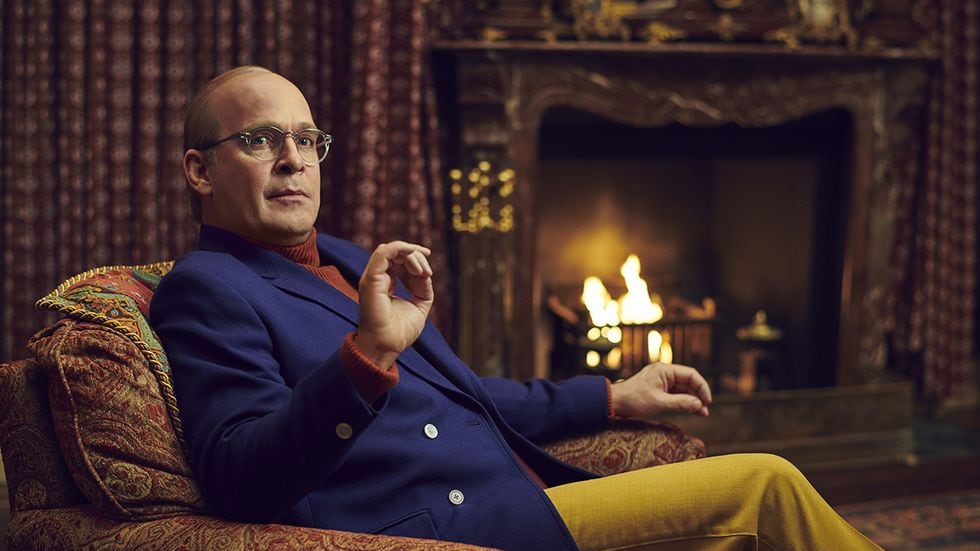Thirteen years before he died, Truman Capote was already calling Answered Prayers his “posthumous novel.” The groundbreaking celebrity author of In Cold Blood and Breakfast at Tiffany’s sensed that his final attempt at a novel—one sharing the exploits of his best friends, i.e., New York’s wealthiest families—would be impossible to finish and impossible to live with.
Indeed, Capote’s last decade-plus, as seen in Feud: Capote vs. the Swans, is a long, slow demise: death by drink, death by disappointment, death by plummeting from the highest social rung after years of climbing.
The FX anthology series depicts the fallout of Capote’s gambit to publish the private lives of his closest friends and confidantes—the influential socialites he called his “Swans.” The show, currently halfway through its run, is fueled by a stacked cast of actresses (Naomi Watts, Diane Lane, Chloë Sevigny), a body-and-soul Tom Hollander performance as Truman and the best directing of Gus Van Sant’s last 15 years.
Van Sant, the legendary Portland director of Drugstore Cowboy and My Own Private Idaho, helms the first four episodes of super-producer Ryan Murphy’s second season of Feud (the first, in 2017, covered the bloody-red showdown between Joan Crawford and Bette Davis). But Van Sant and writer Jon Robin Baitz—adapting Laurence Leamer’s book Capote’s Women—exhibit far more patience, repressed emotion, and formal curiosity than are typical of a Murphy production.
Worry not, there is feuding. Capote’s virtuosic shit talk commands the lens more than once. Hollander’s 50-something Capote is sloshier and looser than Philip Seymour Hoffman’s and Toby Jones’ more controlled Trumans from the In Cold Blood era.
With his head tipped up and askew, often obscuring any emotion in his eyes, Hollander takes the author’s iconically wrinkly voice on long diatribes, like a backbiting theremin solo with a beginning and end known only to the instrument. Good luck to anyone on the receiving end, like disgraced socialite Ann Woodward (Demi Moore), who Capote is convinced murdered her husband.
The show itself, however, harbors little contempt for the Swans. At the front of the bevy is Babe Paley (Naomi Watts), a monument to wounded elegance, who suffers from what Capote calls “ballerina pain.” She looks the porcelain part as a kind of defense against chemotherapy’s ravages and the torrid affairs of her husband, CBS mastermind Bill Paley (Treat Williams, who died last year). “There is no greater WASP,” Capote observes of Babe.
From the opening moments of the show, Capote’s questions to a freshly distressed Babe—”tell me everything…from the beginning”—are those of both the best friend and the information hound. When he publishes a barely fictionalized account of the Swans’ private dramas in Esquire in 1975, they move to oust the telltale in their midst, a decision complicated by the fact that he is, arguably, the only man who shows them love.
The central character dynamics here—codependency, doom, and the ironic space between social selectiveness and alienation—probably don’t necessitate an eight-hour show. Still, the second season of Feud is a genuine showcase for Van Sant and a reminder that he has been, at times, one of the most creative filmmakers of the past 40 years.
Episode 1, for example, leaps back and forth through decades. And while it would be tempting to ensnare the viewer in the sheer polish of Manhattan penthouses and Hollywood villas, this first hour is completely awash in piercing morning light—at Truman’s never-ending hangover of an apartment and the Swans’ center table at La Côte Basque. Through lighting choice alone, we understand that these are peace times, yet everyone’s age and insecurities are already on gleaming display, just waiting to be further exposed.
Van Sant swings even further in Episode 3, which unfolds as an imagined film by the Maysles brothers (Grey Gardens, Gimme Shelter). The hourlong faux-document purports to capture the historical event that was Capote’s 1966 Black and White Ball, a party so grand writer Leo Lerman once called it “one of [Capote’s] major works.”
Here’s a documentary that never existed—though the Maysles did once film a Capote short, albeit one not about the ball—presented as nonfiction to comment on Capote’s own intrusive yet slippery storytelling methods. And what a showcase for Van Sant’s formal talents and interests. You suddenly remember he’s the artist who remade Psycho shot for shot, as he perfectly mimics the Maysles’ canny insert shots and the “I’m still shooting as the subject chases me from the room” backpedals. As a delightful bonus, Diane Lane (as Swan and fashion icon Slim Keith) is completely unlocked by the visual key change in Episode 3, gesturing and scolding for the “Maysles” camera that her character now knows is there.
With Capote vs. the Swans half over and mostly done with Van Sant’s episodes (he’s back for Episode 6), the battle lines are drawn. On one level, it’s obvious where the series is going. Cancer, betrayal, addiction—these forces tend to write their own endings.
On another, the show is intentionally adopting the subjectivity of Capote, who treated fact and fiction like Stoli and orange juice. The truth will bend in the temptation to tell it.
SEE IT: Feud: Capote vs. the Swans airs on FX and streams on Hulu.

